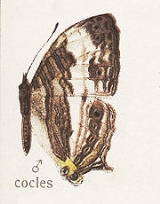
Cyrestis cocles
Encyclopedia
The Marbled Map is a species of nymphalid
butterfly
found in parts of Asia
.
In the dry-season form the upperside is much paler; sometimes fading entirely to creamy white without any wavy markings, except the slender transverse black lines and the line of postdiscal ocelli, which are always more or less present. Underside white, without any pink or pule lilac tint; the markings more faint, but as on the upperside.
Nymphalidae
The Nymphalidae is a family of about 5,000 species of butterflies which are distributed throughout most of the world. These are usually medium sized to large butterflies. Most species have a reduced pair of forelegs and many hold their colourful wings flat when resting. They are also called...
butterfly
Butterfly
A butterfly is a mainly day-flying insect of the order Lepidoptera, which includes the butterflies and moths. Like other holometabolous insects, the butterfly's life cycle consists of four parts: egg, larva, pupa and adult. Most species are diurnal. Butterflies have large, often brightly coloured...
found in parts of Asia
Asia
Asia is the world's largest and most populous continent, located primarily in the eastern and northern hemispheres. It covers 8.7% of the Earth's total surface area and with approximately 3.879 billion people, it hosts 60% of the world's current human population...
.
Description
In the wet-season form both the males and females have a broad transverse median white band on the fore and hind wings. The outer margin of the band is straight while the inner is highly sinuous. The basal and terminal portions of the wings on the inner side of the white band up to the base and on the outer side to the termen more or less greyish brown, traversed by slender sinuous black lines and broader ochraceous-brown lines, the black lines outwardly very narrowly margined with white; the sub-terminal slender black line on both love and hind wing very conspicuous, and within it a transverse post-discal series of obscure dusky-centred greyish irregular ocelli; the termen narrowly greyish; cilia white. Underside pearly white with a faint pinkish or pale lilac tinge, tbe markings of the upperside more or less faintly seen through by transparency; the transverse postdiscal lino of greyish ocelli the most prominent, often centred with black. Antenna: dull brown, head, thorax and abdomen pale greyish brown, the latter two with white lateral longitudinal bands ; beneath whiteIn the dry-season form the upperside is much paler; sometimes fading entirely to creamy white without any wavy markings, except the slender transverse black lines and the line of postdiscal ocelli, which are always more or less present. Underside white, without any pink or pule lilac tint; the markings more faint, but as on the upperside.

